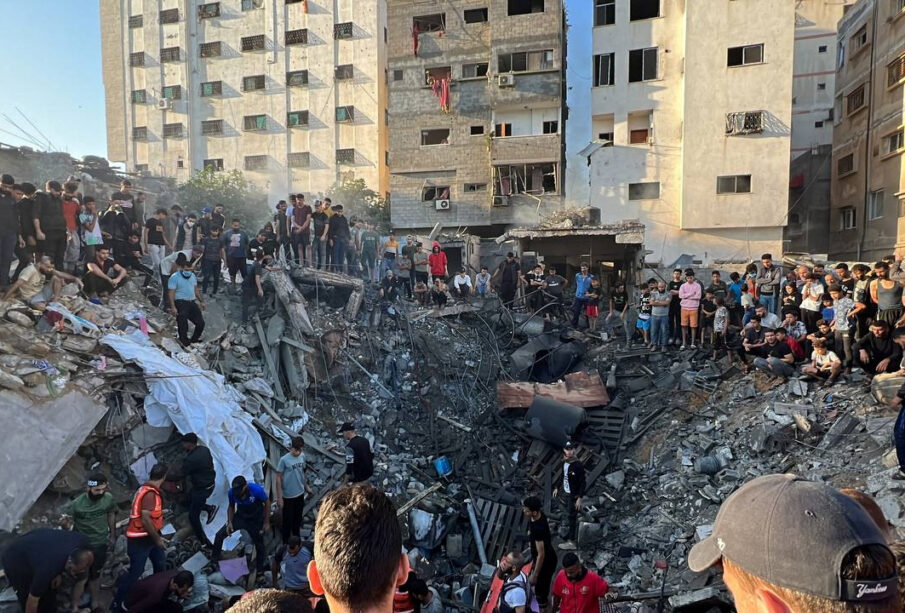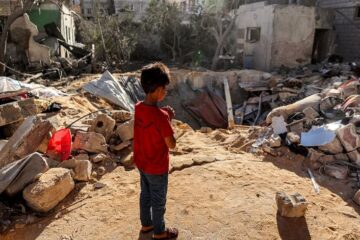Israeli air strikes hammer Gaza anew after Hamas frees two US hostages
 Palestinians gather at the site of an Israeli strike on a house, amid the ongoing conflict between Israel and Palestinian Islamist group Hamas, in Gaza City October 21, 2023. REUTERS/Mutasem Murtaja
Palestinians gather at the site of an Israeli strike on a house, amid the ongoing conflict between Israel and Palestinian Islamist group Hamas, in Gaza City October 21, 2023. REUTERS/Mutasem MurtajaBy Nidal Al-Mughrabi and Emily Rose Reuters
Israel kept up heavy bombardment of targets throughout Gaza overnight on Saturday after Prime Minister Benjamin Netanyahu vowed to “fight until victory” following the release of the first two hostages by the enclave’s ruling Hamas group.
After Netanyahu signalled no pause in Israel’s aerial onslaught and expected ground invasion, its military said fighter jets had struck a “large number of Hamas terror targets throughout the Gaza Strip” including command centres and combat positions inside multi-story buildings.
Palestinian medical officials and Hamas media said Israeli aircraft had overnight targeted several family houses across Gaza, one of the world’s most densely populated places, killing at least 50 people and injuring dozens.
The Israeli military reported a fresh salvo of rockets from Gaza against southern Israeli border communities before dawn, then a lull until sirens sounded in the port city of Ashdod some 40 km (25 miles) north of the Palestinian enclave. There was no immediate word of casualties in either incident.
Hamas on Friday freed Americans Judith Tai Raanan, 59, and her daughter Natalie, 17, who were among 210 kidnapped in its Oct. 7 cross-border attack on southern Israel by militants of the Islamist movement.
An image obtained by Reuters after their release showed the two women flanked by three Israeli soldiers and holding hands with Gal Hirsch, Israel’s coordinator for the captives and missing.
Reached by phone in Bannockburn, Illinois, outside Chicago, Uri Raanan, the teenager’s father, said he spoke with his daughter by phone. “She sounds very, very good, very happy – and she looks good.”
They were the first hostages confirmed by both sides in the conflict to be freed since Hamas gunmen burst into Israel and killed 1,400 people, mainly civilians, in the deadliest single attack on Israelis since the country’s founding 75 years ago.
Gaza’s Health Ministry says Israel’s retaliatory air and missile strikes have killed at least 4,137 Palestinians, including hundreds of children, while over a million of the besieged territory’s 2.3 million people have been displaced.
Israel has amassed tanks and troops near the fenced border around the small coastal enclave for a planned ground invasion with the objective of annihilating Hamas, after several inconclusive wars dating to its 2007 seizure of power in Gaza.
The first emergency humanitarian aid convoy to be sent to Gaza Strip since the war erupted began moving through the Rafah border crossing from Egypt on Saturday after days of diplomatic wrangling over conditions for delivering the relief.
The United Nations said the 20-truck convoy included life-saving supplies that would be received by the Palestinian Red Crescent. Hamas said the delivery included medicine and limited amounts of food but not fuel.
The Israeli military said that humanitarian aid entering Gaza would go only to southern areas of the enclave, where it has urged Palestinian civilians to congregate to avoid its fighting with Hamas.
U.N. officials say at least 100 trucks a day are needed in Gaza to cover urgent needs, and that any delivery of aid needs to be sustained and at scale. Before the outbreak of conflict, an average of about 450 aid trucks were arriving daily in Gaza, which has been under Israeli and Egyptian blockade for years.
U.N. Secretary-General Antonio Guterres toured the checkpoint on Egypt’s side on Friday and called for a meaningful number of trucks to enter Gaza daily, and checks – which Israel insists on to stop aid reaching Hamas – to be quick and pragmatic.
HOSTAGE RELEASE
Netanyahu said late on Friday that Israel would not give up its effort to “return all abducted and missing people.
“At the same time, we’ll continue to fight until victory.”
Abu Ubaida, a spokesperson for Hamas’ armed wing, said the hostages were released in part “for humanitarian reasons” in response to Qatari mediation efforts.
Israeli Defence Minister Yoav Gallant said achieving Israel’s objectives would not be quick or easy.
“We will topple the Hamas organisation. We will destroy its military and governing infrastructure. It’s a phase that will not be easy. It will have a price,” Gallant told a parliamentary committee.
He added that the subsequent phase would be more drawn out, but was aimed at achieving “a completely different security situation” with no threat to Israel from Gaza. “It’s not a day, it’s not a week, and unfortunately it’s not a month,” he said.
ORTHODOX CHURCH HIT IN AIR STRIKE
The Orthodox Patriarchate of Jerusalem, the main Palestinian Christian denomination, said that Israeli forces had struck the Church of Saint Porphyrius in Gaza City, where hundreds of Christians and Muslims had sought refuge.
The Israeli military said part of the church was damaged in a strike on a nearby militant command centre.
Israel has already told all civilians to evacuate the northern half of the Gaza Strip, which includes Gaza City. Many people have yet to leave saying they fear losing everything and have nowhere safe to go with southern areas also under attack.
Asked if Israel had so far followed the laws of war in its response, U.S. Secretary of State Antony Blinken reiterated on Friday that Israel had the right to defend itself and make sure Iran-backed Hamas was not able to launch attacks again.
“It’s important that operations be conducted in accordance with international law, humanitarian law, the law of war,” he said.
The United Nations humanitarian affairs office said more than 140,000 homes – nearly a third of all homes in Gaza – had been damaged, with nearly 13,000 completely destroyed.
Western leaders have so far mostly offered support to Israel’s campaign against Hamas, although there is mounting unease about the plight of civilians in Gaza.
Many Muslim states, however, have called for an immediate ceasefire, and protests demanding an end to the bombardment were held in cities across the Islamic world on Friday.
In the Israeli-occupied West Bank, where violence has escalated since Israel began bombarding Gaza, Israeli troops shot dead a Palestinian teenager during clashes near the city of Jericho.
Since the Israel-Hamas war erupted, the borderlands between south Lebanon and northern Israel have also seen constant but so far limited clashes between the Israeli military and fighters from the Lebanese Shi’ite Islamist group Hezbollah.
The Israeli military said on Saturday a soldier had been killed by a missile attack on the Lebanese border, in a statement that did not elaborate on the exact time or location.









